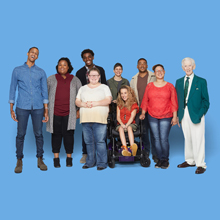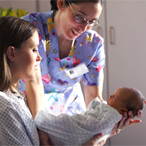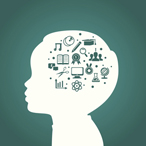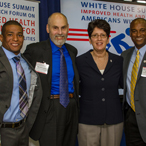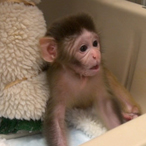Over the past year, NICHD contributed to numerous scientific advances and key initiatives.
News
NICHD issues News Releases and Media Advisories to the news media. Spotlight and Research Feature articles explain NICHD research findings and public health issues to the general public. An Item of Interest is a short announcement of relevant information, such as a notable staff change.
NIH awards nearly $100 million for Autism Centers of Excellence program
The National Institutes of Health has awarded nine research grants totaling nearly $100 million over the next five years for the Autism Centers of Excellence (ACE), a program that supports large research projects aimed at understanding and developing interventions for autism spectrum disorder (ASD).
Children’s visual engagement is heritable and altered in autism
How children visually engage with others in social situations is a heritable behavior that is altered in children with autism, according to a study funded by the National Institutes of Health.
The NIH NeuroBioBank: Addressing the Urgent Need for Brain Donation
NICHD Director Dr. Diana Bianchi and colleagues from other NIH Institutes discuss this valuable research resource.
Neuroimaging technique may help predict autism among high-risk infants
An imaging technique called fcMRI may predict which high-risk, 6-month old infants will develop autism spectrum disorder by age 2 years, according to an NICHD-funded study.
Early brain changes may help predict autism among high-risk infants
Brain changes at age 6 or 12 months may help predict the development of autism spectrum disorder by age 2 years among infants with a high family risk, according to a study funded by NICHD.
Home-visit program in child maltreatment cases strengthens parent-child interaction
Parents previously investigated for child abuse, showed more positive responses to their baby’s social and emotional needs after completing a home-visit program, according to a study supported by the Eunice Kennedy Shriver National Institute of Child Health and Human Development.
Selected NICHD Research Advances of 2016
NICHD had a very productive year in 2016. Staff responded quickly to Zika virus and led the effort to develop the NIH Research Plan on Rehabilitation. The following snapshots are examples of the many advances made possible by NICHD this year.
Getting to Know the New NICHD Director
NICHD Director Dr. Diana Bianchi shares some thoughts about joining NICHD.
Resources to Help Families and Physicians Spot Early Signs of Autism
For people with autism spectrum disorder (ASD), early detection and early intervention can help a great deal in improving outcomes. The American Academy of Pediatrics recommends that health care providers screen for ASD at the 18-month and 24-month visits. Meanwhile, researchers are working to develop screening tools that can detect the disorder even earlier.
Spotlight: NICHD Needs Your Input for the All of Us Research Program
NICHD needs your input for NIH’s All of Us program.
Selected NICHD Research Advances of 2015
Over the past year, NICHD contributed to numerous scientific advances and key initiatives.
Environmental Influences on Child Health Outcomes
NIH seeks input on a proposed new research program to assess biological, chemical, psychosocial, and other environmental influences on child health outcomes. Join one of NIH’s webinars to learn more.
Studying the Growing Brain: A Q&A on the C-MIND Study
The Cincinnati MR Imaging of Neurodevelopment (C-MIND) study was launched in 2009 to establish a new resource for the research community: a database of scans showing the structure and activity of the growing brain. C-MIND has taken an unprecedented look at what’s going on inside the heads of hundreds of kids from ages 0 to 18.
Neuroscience Research Resources
NICHD supports a variety of research projects and networks that are useful to neuroscientists. Find a detailed list here.
Animals’ presence may ease social anxiety in kids with autism
When animals are present, children with autism spectrum disorders (ASDs) have lower readings on a device that detects anxiety and other forms of social arousal when interacting with their peers.
NICHD Co-Sponsors White House Disability Summit
More than 50 million Americans, about 1 in 5 people, are living with a disability. People with disabilities tend to be less physically active than people without disabilities and have higher rates of corresponding health problems such as obesity, heart disease, hypertension and stroke.
Encouraging Healthy Child Development with Birth to 5: Watch Me Thrive!
A recent survey shows that one in four young children (ages birth to 5) are at moderate to high risk for developmental, behavioral, or social delays.1 To raise awareness of these risks and promote early screening, the NICHD has joined the Administration for Children and Families and a number of other federal partners in launching Birth to 5: Watch Me Thrive!
Common gene variants account for most genetic risk for autism
Most of the genetic risk for autism comes from versions of genes that are common in the population rather than from rare variants or spontaneous glitches, researchers funded by the National Institutes of Health have found. Heritability also outweighed other risk factors in this largest study of its kind to date.
Oxytocin promotes social behavior in infant rhesus monkeys
The hormone oxytocin appears to increase social behaviors in newborn rhesus monkeys, according to a study by researchers at the National Institutes of Health, the University of Parma in Italy, and the University of Massachusetts Amherst. The findings indicate that oxytocin is a promising candidate for new treatments for developmental disorders affecting social skills and bonding.
 BACK TO TOP
BACK TO TOP










